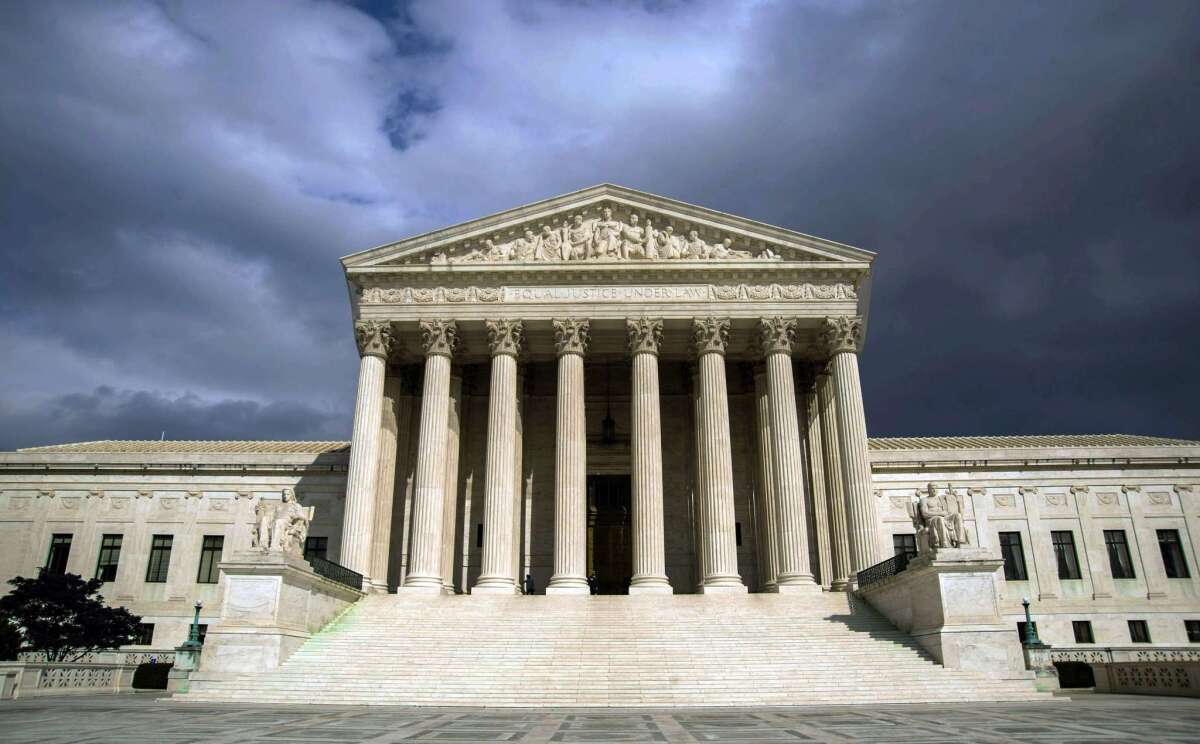In Supreme Court case, university defends race-based policy giving middle-class minorities an edge

The U.S. Supreme Court building in Washington, D.C.
With the constitutionality of race-based affirmative action hanging by a thread at the Supreme Court, University of Texas officials are struggling to explain a policy that gives an extra edge to Latino and African American students from middle-class households and top-performing high schools.
It is called “qualitative diversity,” and premiere state universities, including the University of California, insist such policies are vital to preserving academic standards and combating stereotypes about minorities.
The case of Fisher vs. University of Texas began six years ago when a rejected white student complained about the role race played in deciding who was admitted to the Austin campus.
Now, as the case returns for a second time to the high court, it has triggered a heated debate over who should benefit from affirmative action, what counts as diversity and whether minority students from integrated suburban high schools may contribute more on campus that those from inner-city high schools.
For about 80% of its admissions, the university currently operates under a race-neutral state law that awards admission to students who graduate in the top 7% of their high school class. (In an earlier version, it was the top 10%.) The law has resulted in an influx of minority students to Austin, mainly from schools in low-income areas in the Rio Grande Valley and in the center cities of Houston, Dallas and San Antonio.
But citing its interest in the “educational benefits of diversity,” the university says it also needs to supplement that policy with a race-based one to admit promising minority students who are not in the top 7% of their class, including “the African American or Hispanic child of successful professionals in Dallas.”
Critics say the policy is not only unfair to similar white students from the same schools, it effectively turns its back on the idea that affirmative action is intended to benefit disadvantaged students.
“Preferring minority students from wealthier, integrated backgrounds over minority students who have flourished despite economic hardships is at best counter-intuitive, if not an outright distortion of the diversity rationale,” said lawyers for Abigail Fisher, the white student who sued the university after she was denied admission in 2008.
Race-based admission policies have long drawn scrutiny from the Supreme Court, which will hear arguments in the case Dec. 9.
The court’s conservatives say the guarantee of “equal protection” forbids universities from using race in deciding who is admitted. Often joining them is Justice Anthony M. Kennedy, who has regularly voted to limit affirmative action, but stopped short of prohibiting such policies entirely. Race, he has said, may be used only as a “last resort.”
Two years ago, when the court first took up the Texas case, Kennedy wrote an opinion that told the 5th Circuit Court of Appeals to take a second, more skeptical look at the admissions policy in Austin to decide if the university still needed “to use race to achieve educational diversity” or “could achieve sufficient diversity without using racial classifications.”
When the lower court ruled again for the university, the high court agreed to hear the case again.
The university’s argument is complicated by the growing number of minority students earning admission based solely on their grades. In 2008, when Fisher applied, about one-fourth of the incoming students were Latino or black. Last year, 35% of the freshmen were “underrepresented minorities.” While this is the kind of “race-neutral” policy Kennedy has lauded, the university’s lawyers say it relies on the “well-known fact that the Texas school system remains largely segregated.”
About 75% to 80% of the freshmen are admitted based on their grades. But to fill the remaining spots, the university says it needs to consider race to admit promising minority students from competitive, integrated high schools who may fall outside the top 7%.
Diversity does not “depend on skin color alone” and cannot be “measured by counting students of color on campus,” its lawyers argue.
Minority students from top-performing schools have “different backgrounds and perspectives [and] they help ensure that UT’s admissions policy does not reinforce stereotypes that Hispanics come from ‘the valley’ and African Americans come from the ‘inner city,’” they said.
Many of the nation’s top state universities joined in support of Texas. University of California lawyers filed a brief arguing for “qualitative diversity” on campus. They say “race neutral” admissions policies like the one in Texas will not work in states like California, and they may prevent universities from admitting even more qualified minorities.
Richard Kahlenberg, a leading advocate of need-based affirmative action, says universities should give breaks to students -- regardless of their race -- who come from low-income families and whose parents did not go to college. He said focus on race over economic and social disadvantage has put Texas in a tight spot. “They’re in the tough position of arguing for preferences for middle- and upper-middle income students,” he said.
Though the university argues minority students from higher-ranked schools would bring new perspectives to campus debates, Kahlenberg questioned that premise.
“If one is looking for a lively discussion from students with the greatest possible variety of backgrounds, then including a poor white student from a trailer park might add more diversity than a wealthy African American graduate of a prep school,” he argued in a friend-of-the-court brief.
Civil rights groups are backing the university. “While the top 10% plan did help UT achieve some measure of diversity, based in no small part on residential segregation in Texas, it was not sufficient to achieve the diverse student body the university sought,” said Rachel Kleinman, a lawyer for the NAACP Legal Defense and Education Fund.
The case comes before the justices in a year that has seen “poignant reminders” of the importance of race and “its continuing relevance in America today,” the university said. In August, students at Austin led the effort to remove a statue of Jefferson Davis from a campus mall.
At first glance, Fisher did not appear to have a strong case when she sued. She was a good, but not outstanding student from Sugar Land, Texas, who was not in the top 10% of her class. She alleged she was a victim of illegal discrimination because the university used race as a factor in admitting about 20% of its freshman class. Once rejected at Austin, Fisher went to Louisiana State University and graduated from there.
But her lawsuit has remained alive. The university says Fisher would not have won admission under any circumstances, and its lawyers argue her suit should be tossed out now because she has no standing to sue.
On Twitter: @DavidGSavage
ALSO
Plan for Virginia mosque becomes target of post-Paris anti-Muslim backlash
Young immigrants are at risk from sponsors with criminal records, senators say
From despised rodent to beloved icon, Texas Panhandle prairie dogs put on a show
More to Read
Start your day right
Sign up for Essential California for news, features and recommendations from the L.A. Times and beyond in your inbox six days a week.
You may occasionally receive promotional content from the Los Angeles Times.







